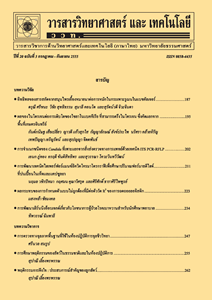ผลของ Folic Acid ต่อการเจริญเติบโตและสารต้านอนุมูลอิสระของผักบุ้งจีน (Ipomoea aquatica Forsk.)
Main Article Content
Abstract
บทคัดย่อ
Folic acid (FA) จัดเป็นสารกระตุ้นชีวภาพ (biotic elicitor) ที่ใช้ส่งเสริมการสร้างสารต้านอนุมูลอิสระในพืช โดยการใช้สารกระตุ้นนอกจากชนิดของสารกระตุ้นจะมีความสำคัญแล้ว ยังขึ้นอยู่กับความเข้มข้น และระยะการเจริญเติบโตของพืชอีกด้วย การใช้ FA ในพืชผักชนิดต่าง ๆ เพื่อกระตุ้นให้สร้างสารต้านอนุมูลอิสระมีการศึกษามาบ้างแล้ว แต่ยังไม่มีการศึกษาในผักบุ้งจีน (Ipomoea aquatica Forsk.) ซึ่งจัดเป็นผักเศรษฐกิจในประเทศไทย ดังนั้นในการทดลองนี้จึงศึกษาผลของการให้ FA ความเข้มข้นต่างๆ ในระยะเมล็ดและต้นกล้า ต่อการงอก การเจริญเติบโต และสารต้านอนุมูลอิสระของผักบุ้งจีน โดย priming เมล็ดด้วย FA ความเข้มข้น 0 25 50 100 200 และ 400 µM เปรียบเทียบกับเมล็ดที่ไม่ผ่านการ priming เป็นสิ่งทดลองควบคุม พบว่า ความงอกในแปลง ระยะเวลาเฉลี่ยในการงอก ความสูงต้น น้ำหนักแห้งต้น ปริมาณสารประกอบฟีนอลิกทั้งหมด และฤทธิ์ต้านอนุมูลอิสระ 2,2-diphenyl-1-picrylhydrazyl (DPPH) ไม่แตกต่างกันทางสถิติในทุกสิ่งทดลอง ส่วนการพ่น FA ความเข้มข้น 25 50 100 200 และ 400 µM ให้กับผักบุ้งจีน ที่อายุ 14 วันหลังหยอดเมล็ด เปรียบเทียบกับสิ่งทดลองควบคุมที่ไม่มีการพ่น เก็บเกี่ยวเมื่ออายุ 20 วัน หลังหยอดเมล็ด พบว่าการไม่พ่นและพ่น FA ทุกความเข้มข้น ผักบุ้งจีนมีความสูงต้น น้ำหนักแห้งต้น และฤทธิ์ต้านอนุมูลอิสระ DPPH ไม่แตกต่างกันทางสถิติ การพ่น FA ความเข้มข้น 50, 100, 200 และ 400 µM สารประกอบฟีนอลิกทั้งหมดในผักบุ้งจีนมีปริมาณสูงและไม่แตกต่างกันทางสถิติ แต่ปริมาณสารประกอบฟีนอลิกทั้งหมดมีแนวโน้มลดลงเมื่อพ่น FA ความเข้มข้น 200 และ 400 µM
คำสำคัญ : Ipomoea aquatic; folic acid; สารประกอบฟีนอลิก; ฤทธิ์ต้านอนุมูลอิสระ DPPH
Abstract
Folic acid (FA) is a biotic elicitor being used for promoting the antioxidant production in plants. The elicitor application depends on not only its type but also concentration and growing period of plant. Several studies in vegetables have applied FA as elicitor, but there was no report in kangkong (Ipomoea aquatica Forsk.) which is the economical vegetable in Thailand. Therefore, the effect of FA application in seed and seedling at various concentrations on germination, growth and antioxidants were examined in kangkong. The seeds were subjected to priming by soaking with 0, 25, 50, 100, 200 and 400 µM FA compared with non-primed seeds as control. The results indicated that field emergence, mean time to emergence, shoot height, shoot dry weight, total phenolic content and 2,2-diphenyl-1-picrylhydrazyl (DPPH) radical scavenging capacity were not significantly different among the treatments. The 25, 50, 100, 200 and 400 µM of FA were sprayed at 14 days after sowing compared with non-sprayed as control. The plants were harvested at 20 days after sowing. Shoot height, shoot dry weight and DPPH radical scavenging capacity were not significantly different under non-sprayed and FA treatments. The 50, 100, 200 and 400 µM FA foliar applications showed high contents of total phenolic with non-significant difference. However, total phenolic contents trended to decrease in 200 and 400 µM FA treatments.
Keywords: Ipomoea aquatic; folic acid; phenolic compound; DPPH radical scavenging capacity


